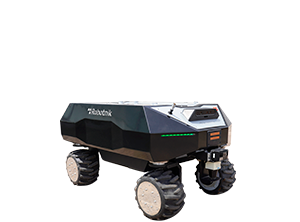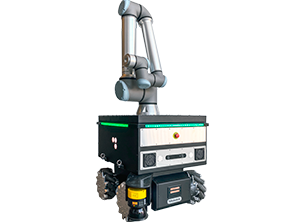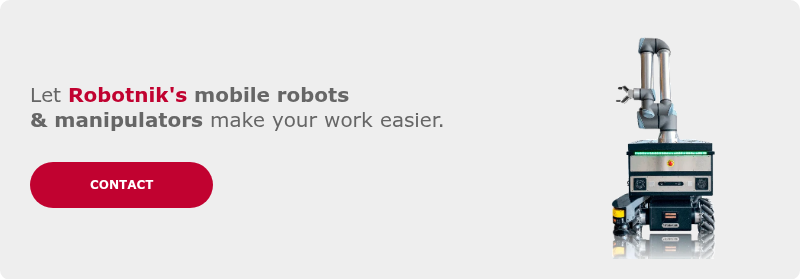Advances in research, biotechnology, pharmaceuticals, and clinical diagnostics demand increasingly fast, precise, safe, and efficient processes. In this context, automation and robotics have become key tools to minimize errors, shorten experimental cycles, and free scientific personnel from repetitive tasks, allowing them to focus on higher-value activities.
This has led to the concept of the smart laboratory: one that integrates technological tools such as robotics, Artificial Intelligence, and digitalization systems to optimize and accelerate certain processes, enable more advanced decision-making, and improve researcher safety.
This article presents some of the applications that mobile manipulators robots as RB-THERON+ can perform in laboratory environments, their advantages, challenges, and future trends.
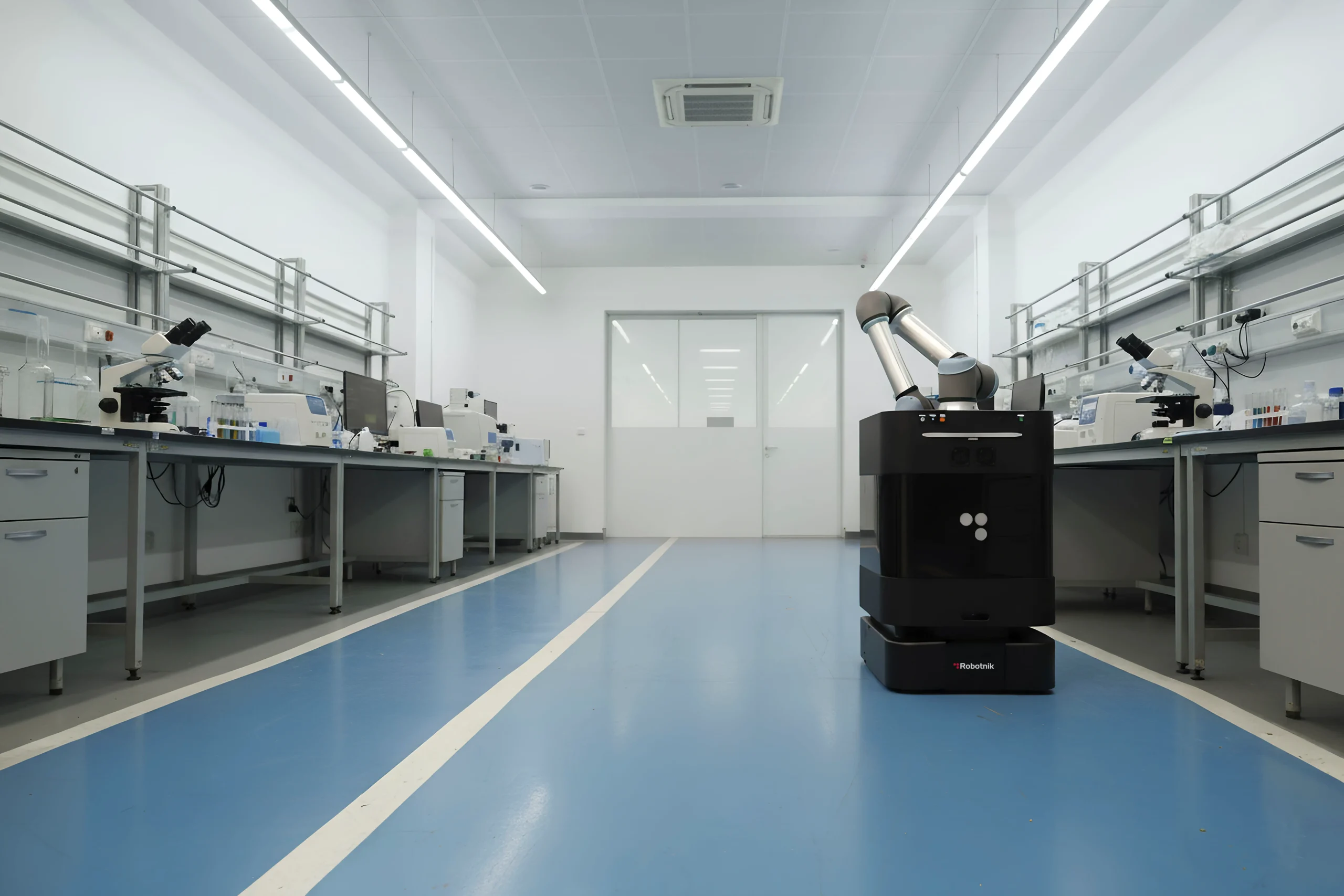
AUTOMATION IN LABORATORIES: TREND-SETTING DATA
The recent World Robotics Service 2025 report from the International Federation of Robotics (IFR) highlighted that the diagnostics and laboratory analysis sectors experienced unprecedented growth in mobile robotics adoption in 2024, with nearly 3,300 units sold, representing a 610% increase compared to the previous year.
This extraordinary growth reflects the rising demand for robotic solutions aimed at laboratory automation, particularly in the European market. The report notes that numerous traditional industrial robot manufacturers supplied equipment for medical and laboratory applications for the first time, indicating a convergence between the industrial and biomedical sectors. Key factors driving this trend include demographic shifts reducing the availability of specialized personnel and the need to maintain productivity and traceability in highly regulated environments.
CHALLENGES OF MOBILE ROBOTICS IN LABORATORY ENVIRONMENTS
According to the aforementioned World Robotics Service 2025 report, the development of robotics for laboratory automation is driven by the growing need for efficient solutions to support medical and technical staff amid staff shortages and increasing workloads. This context has accelerated the adoption of mobile robots and manipulators capable of performing repetitive tasks with high precision and safety. The report also emphasizes the importance of interdisciplinary collaboration among engineers, biotechnology specialists, and AI experts as a key factor in developing advanced systems capable of automating complex processes and improving the traceability of experimental results.
However, implementing mobile robotics in laboratories presents specific challenges that cannot be addressed by adapting conventional industrial robots. Laboratory environments impose highly specific technical and operational requirements, including:
-
- Limited space and narrow corridors: Many laboratory areas lack sufficient room for wide maneuvers, requiring robots to be compact and highly maneuverable.
- Precision and smooth movement: Robots must handle delicate items such as microplates, vials, or test tubes, requiring stable and controlled motion.
- Safety and collision detection: In collaborative workspaces, avoiding accidents with personnel or sensitive equipment and minimizing the risk of handling reactive fluids or hazardous materials is essential.
- Autonomy and charging: Robots must operate for extended periods without constant supervision, optimizing energy use and automatically managing charging cycles.
- Modular flexibility: Laboratory processes change frequently, so robotic platforms must adapt to new tasks and configurations without requiring complex redesigns.
These requirements determine that mobile robots for laboratory use must be compact, modular, safe, and easily integrable into existing infrastructure.
RB-THERON+ is Robotnik’s Autonomous Mobile Manipulator, designed to meet these operational and technological demands in laboratory environments.
ADVANTAGES OF MOBILE ROBOTICS FOR LABORATORIES
Many routine tasks in laboratory research are unavoidable but time-consuming. Tasks such as sample transport, reagent handling, or moving equipment can be delegated to autonomous machines, saving researchers valuable time.
In laboratory and pharmaceutical environments, bottlenecks often occur not in technical analysis but in the physical movement of objects between areas. Automating these transport tasks with robots allows for faster internal workflows.
Mobile robotics enables these tasks to be handled autonomously, freeing staff to focus on higher-value scientific activities and improving operational efficiency.
Key advantages include:
-
- Reduction of human error: Automated handling of samples and reagents minimizes contamination risks, labeling mistakes, and material loss, ensuring greater reliability of results.
- Optimization of time and resources: Automating internal transport and material handling reduces bottlenecks from repetitive physical tasks, increasing overall laboratory productivity.
- Improved personnel safety: Mobile robots prevent direct exposure to hazardous chemicals, infectious samples, or sensitive materials, reducing accident risk and ensuring safer work environments.
- Flexibility and adaptability: Autonomous systems can be reconfigured for different tasks, adapting to changes in workflow or new experimental needs without significant additional investment.
- Scalability for modern laboratories: Mobile robots allow operational capacity to expand without proportionally increasing staff, facilitating infrastructure growth and sample processing capabilities.
REAL APPLICATIONS OF MOBILE MANIPULATORS IN LABORATORIES
Some of the tasks a mobile manipulator can perform to reduce workload in laboratories include:
Handling biological or chemical samples
-
- Picking up, transporting, and placing test tubes or vials
- Precise liquid transfers between containers
- Preparing samples for automated analysis
Reagent dosing and mixing
-
- Accurate measurement of volumes according to predefined protocols
- Controlled agitation of reagents
- Reducing human error in repetitive or critical tasks
Loading and unloading analysis equipment
-
- Inserting and removing plates or tubes from centrifuges, analyzers, or incubators
- Automatic feeding of samples to diagnostic devices
Inventory management
-
- Classification and storage of reagents or consumables
- Barcode scanning and automatic logging in inventory systems
- Monitoring expiration dates and stock levels
Preparation of slides and plates
-
- Applying samples to slides for microscopy
- Sealing, labeling, and organizing Petri dishes or microplates
Assistance in repetitive and routine tasks
-
- Washing and drying laboratory materials
- Restocking workstations
- Automated cleaning and disinfection of surfaces or utensils
Internal logistical support
-
- Transporting trays, samples, or materials between laboratory areas
- Coordinating with other automated equipment (e.g., conveyors or fixed robotic arms)
RB-THERON+: AN AUTONOMOUS MOBILE MANIPULATOR FOR LABORATORY AUTOMATION
Fixed robotic solutions, such as desk-mounted arms or dedicated workstations, can automate certain tasks but lack mobility. In contrast, autonomous mobile robots (AMRs) like RB-THERON+ from Robotnik combine mobility, manipulation, and autonomy in a single system.
Advantages of RB-THERON+ over fixed robotic arms include:
-
- Autonomous navigation without guides: Uses SLAM technology with LiDAR sensors, RGB-D cameras, and 2D scanners, eliminating the need for physical beacons or guide rails
- Hardware and software modularity: Configurable based on the application, with different mobile bases (differential or omnidirectional) and expandable batteries
- ROS 2 architecture: Over 400 packages available for customization with languages such as C++, Python, or HTML
- Teleoperation and remote control: Advanced HMI interface for monitoring, configuration, and control at a distance
- Certified safety: Compliance with ISO 3691-4 and ISO 13482, integrated collision avoidance system, and emergency stop button
These capabilities make RB-THERON+ an optimal solution for laboratories seeking flexible, safe, and scalable automation, adapted to the demands of modern research.
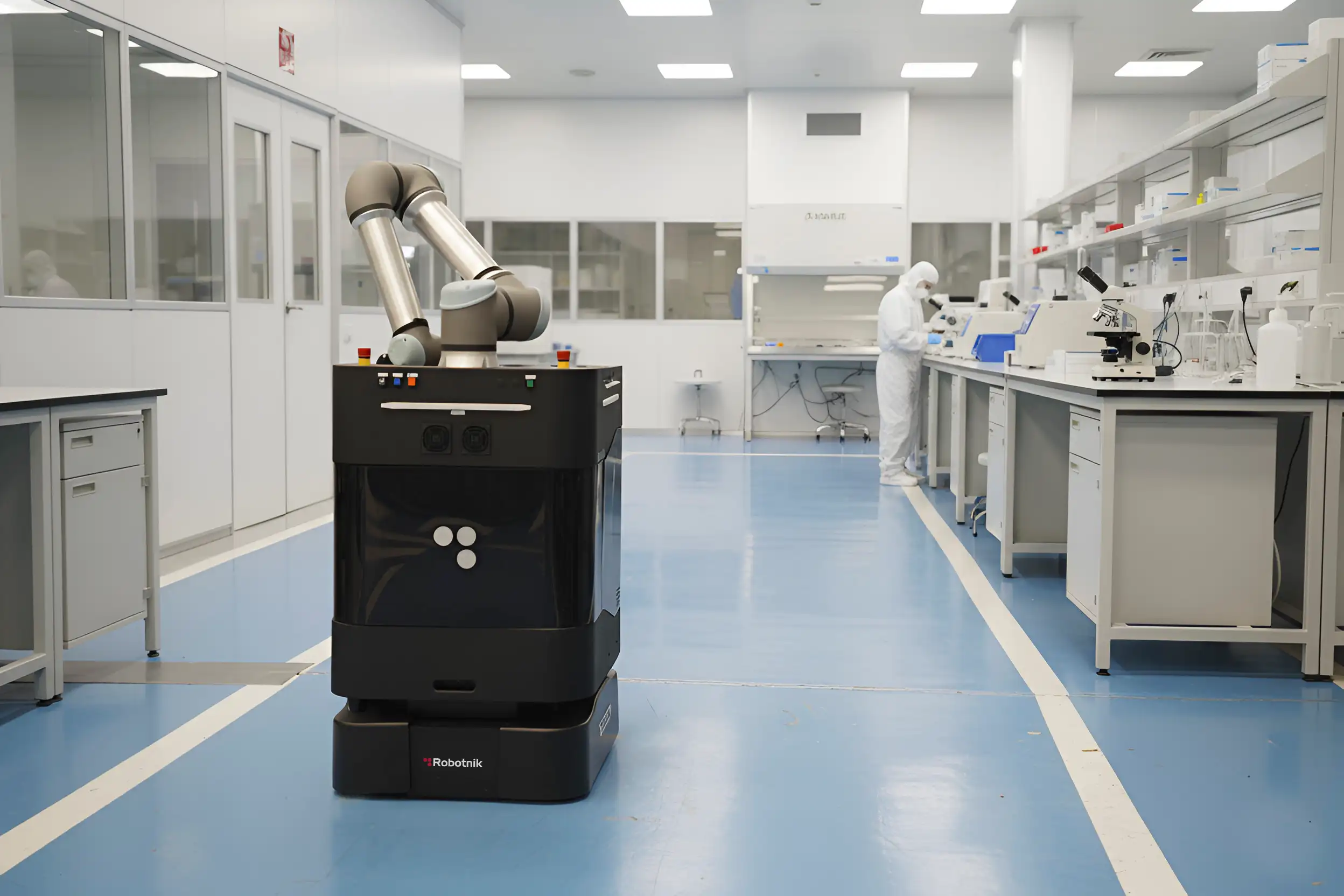
SERVICE ROBOTS IN LABORATORIES: TOWARD PROGRESSIVE AUTOMATION
Service robotics in laboratories, closely linked to medical and diagnostic applications, is becoming a key element in smart laboratories. The shortage of skilled personnel and the costs of manual tasks make mobile robots and manipulators, such as RB-THERON+, strategic allies for taking on repetitive processes, freeing staff for higher-value scientific activities.
Although the number of service robots capable of fully independent operation is still limited, technological development is progressing steadily, allowing gradual integration into smart laboratories. Many robotic solutions are still in pilot phases or controlled deployments, where autonomous operation is combined with human supervision to ensure safety and reliability.
In this context, systems like RB-THERON+ already demonstrate the benefits of mobile robotics in real laboratory environments, performing logistical and manipulation tasks. They represent an intermediate step toward full automation, where robots not only accelerate routine processes and relieve staff of monotonous tasks but also lay the foundation for fully automated, safe, and scalable laboratories, capable of adapting to the challenges of modern research.
Preguntas frecuentes sobre sobre róbotica para lavado de vehículos
El RB-KAIROS+ es un manipulador móvil autónomo desarrollado por Robotnik que integra un brazo colaborativo y una plataforma omnidireccional. En el sector del lavado de vehículos se utiliza para automatizar tareas que requieren precisión y repetibilidad, como la aplicación de jabones y ceras, el escaneo de la carrocería o las operaciones de acabado.
El uso de robots como el RB-KAIROS+ reduce riesgos laborales, optimiza recursos como agua, químicos y energía, mejora la calidad y consistencia de los resultados y libera a los operarios de tareas repetitivas, permitiéndoles enfocarse en actividades de mayor valor añadido.
El robot reduce el consumo de agua, energía y productos químicos mediante aplicaciones precisas y controladas, lo que disminuye el impacto ambiental y genera ahorros para las empresas.
